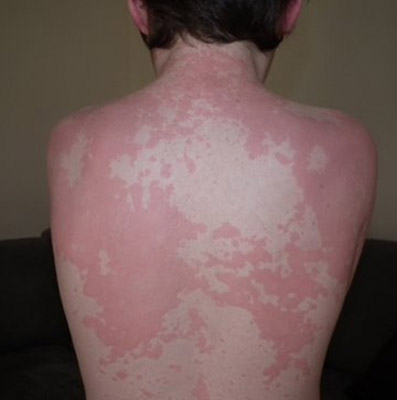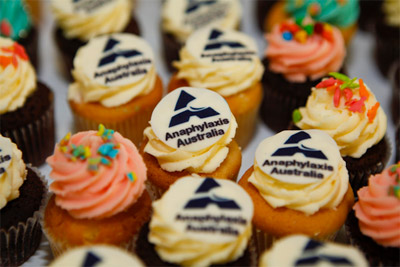Maria Said Anaphylaxis Australia Interview

Maria Said Anaphylaxis Australia Interview
Food Services Industry staff are being implored to take allergies seriously as the incidence of potentially life threatening allergies is reaching epidemic proportions in Australia.
Recent research shows the majority of food allergic reactions occur when eating outside the home, many in restaurants and cafes.
Approximately nine foods cause about 90% of all reactions, with dangerous foods often appearing in unexpected places - from shellfish in soup stock to nuts used in flour.
Maria Said, President of Anaphylaxis Australia, said the food service industry not only has a role to play, but a responsibility.
"This is a real food safety issue, just like salmonella...and it's important that the food service industry takes it seriously."
Anaphylaxis Australia receives roughly one report a week of someone having experienced an allergic reaction whilst eating out even though they had disclosed their allergy to the food service provider.
"If someone has an allergy, it's not up to the 15 year-old waitress to keep that in mind, it's up to everyone in that facility to have an understanding that the person at table four has a potentially life-threatening allergy," Ms Said said.
Chef Alex Herbert, agreed, saying food industry staff need to treat any customer's allergy as potentially life threatening. Those with a food allergy must disclose their allergy so that staff can take extra care in preparing their meal.
Awareness Can Save Lives
Awareness and education could have saved Shane Townsend's wife from falling into a coma within an hour of realising there had been nuts in her meal, even though she'd told staff she was allergic.
Richelle Townsend suffered an anaphylactic reaction in 1991 after eating at a restaurant. She has been in a nursing home ever since.
"When something like this happens you realise that things worse than death can happen, and this is one of them", said Mr Townsend.
Anaphylaxis isn't as rare as you'd think: roughly ten people die of an anaphylactic reaction each year in Australia. Many are treated promptly with adrenaline, either in the community setting or in hospital. Sadly, Mrs Townsend, has a severe brain injury which has left her totally dependent on the care of others.
Anaphylaxis Australia President Maria Said recommends some simple steps for sufferers of food allergy when eating out.
"When properly managed, food allergy sufferers can lead close-to-normal lives", she said. People with food allergy have a primary responsibility to always disclose their allergy to those preparing their food and food service staff must have systems in place to prepare simple foods for someone at risk of anaphylaxis. Anaphylaxis Australia Inc is a non-profit Australian charity which was formed in 1993. AAI's mission is to increase awareness of anaphylaxis through education, research and support. The organisation works with health and teaching professionals, members of the food industry and all who are touched by life-threatening allergy so that, together, we can improve the quality of life of Australians with allergies, nationally.
Anaphylaxis Australia Inc is a non-profit Australian charity which was formed in 1993. AAI's mission is to increase awareness of anaphylaxis through education, research and support. The organisation works with health and teaching professionals, members of the food industry and all who are touched by life-threatening allergy so that, together, we can improve the quality of life of Australians with allergies, nationally.
For more information visit the AAI website: www.allergyfacts.org.au or call 1300 728 000.
Interview with Maria Said
Maria Said from Anaphylaxis Australia has provided an insightful article around the prevalence of anaphylaxis and food allergies, dangers of eating out and some simple steps women can take to protect themselves.
Question: Can you provide some information on the prevalence of anaphylaxis and food allergies?
Maria Said: There are nine foods that account for 90% of food allergic reactions: peanuts, tree nuts (walnuts, almonds, cashews, pistachios, pecans, etc.), fish, crustacea (prawns, lobster, crab etc), eggs, milk, sesame, soy and wheat. The other 10% includes more than 170 foods.
1 in 20 Australians will develop a food allergy in their lifetime.
1 in 100 Australians will have a life-threatening allergy known as anaphylaxis.
Approximately 10 people die from anaphylactic reactions each year in Australia. Peanut allergy is the most common cause of fatal food anaphylaxis.
1 in 10 infants have confirmed food allergy. Egg, peanut and cow's milk are the most common food allergies in children.
Peanuts are the leading cause of severe allergic reactions, followed by tree nuts, crustacea, fish and milk.
Question: What is the difference between anaphylaxis and food allergies?
Maria Said: Anaphylaxis is the most severe form of allergic reaction that someone can have. Triggers of anaphylaxis include insects, foods, medication, latex, exercise and other. Allergic reactions can be mild, moderate or severe. Severe allergic reactions always involve the breathing system and/or the heat and blood pressure system (i.e. the respiratory system and/or the cardiovascular system). Signs of a mild to moderate food allergic reaction include swelling of the face, lips and eyes, hives or welts, abdominal pain or vomiting.
Question: What dangers are involved in eating out for those who have food allergies?
Maria Said: Small amounts of the trigger allergen can cause an allergic reaction. An allergic person eating a small crumb of peanut or a few mls of milk is enough to trigger a potentially life threatening emergency.
When people eat away from home, they need to disclose their allergy, ask about food content and the risk of cross contamination. They need to be given accurate information about food content so they can made an informed decision on whether to eat the food or not. If food service people are not sure about ingredient content, they should say so.
Question: How can woman with food allergies manage eating out at restaurants, cafes and at family and friends homes?
Maria Said: Anyone with an allergy needs to disclose that they are allergic to a food. Often it is health nutritious foods that trigger allergic reactions so it is not like it is something that is rarely in food. People hate drawing attention to themselves but when you have food allergy, you need to communicate it for your safety and the safety of others. Woman can ring the restaurant or cafe beforehand and let them know they will be visiting and maybe discuss safer food options with the chef. Disclosing the allergy again on arrival at the food service location and speaking to a senior person who understands most about food allergy is best. Choose the simpler meals that don't have lots of ingredients. Know what types of foods/restaurants are higher risks for you. If you are seafood allergic, going to a seafood restaurant and expecting a safe meal is not reasonable. Both individuals at risk and food service providers have responsibilities. If a person asks about food content, by law, a food service provider must pass on the allergen content verbally or in writing.
Question: What are some of the simple steps people with allergies can take to protect themselves?
Maria Said: People with allergy need to be assertive but in a way that is not too demanding. Staff need to understand the seriousness of allergy and communicating with the 16yr old waitor/ress is probably not a good idea. Ask to speak with the chef or the manager. If you don't have clear information on food content, don't eat it. Always have your adrenaline autoinjector (EpiPen or Anapen) and your ASCIA Action Plan for Anaphylaxis with you in case of a reaction. Allergic reactions are never planned; you always have to be prepared. Tell your friends about your allergy so they understand what to do if you start showing signs of an allergic reaction.
Question: Can food allergies develop at any age?
Maria Said: Although food allergy is common in early childhood, people can develop a food allergy at any time. Just this morning I was talking with a 39 yr old lady who has developed a potentially life threatening allergy to banana. She has eaten banana all her life without incident until a couple of weeks ago.
 Question: What are the nine foods that cause about 90% of all allergic reactions?
Question: What are the nine foods that cause about 90% of all allergic reactions?Maria Said: Peanut, cow's milk, egg, tree nuts (e.g. cashew, almond, Brazil nut), fish, shellfish, soy, sesame and wheat.
Question: What role do you believe the food service industry should play in regards to food allergies and reactions?
Maria Said: The food service industry not only has a role to play but a responsibility to provide safe food choices to allergic consumers who disclose their allergy. Consumers should always ask about food content and by law, information on whether a food contains the major allergens or not, must be communicated with the customer either verbally or in writing.
Maria Said: The persons ASCIA Action Plan must be followed. If they have been prescribed an adrenaline autoinjector (EpiPen or Anapen) and they have an allergic reaction which is severe, the adrenaline must be administered before an ambulance is called. The instructions on the ASCIA Action Plan must be followed.
Interview by Brooke Hunter
MORE
- Chiropractic Myths & Truths
- Gerard Fogarty Arthritis and Knee Replacement...
- Kym Ellery The ELLERY Eyewear Collection Interview
- Dr Ross Walker The Real Modern Killers Interview
- Shelly Horton Hay Fever Help Interview
- Sebastian VanVeenendaal Royal Rehab's Beach...
- Abigail Koch Family Private Health Insurance...
- Monique Cashion Organic Awareness Month Interview
- Dr Bill Harris Omega-3s Interview
- The Top Ten Health Myths Busted
- Professor Bolin IBD Management a Life-Long...
- Anthia Koullouros Best Cold and Flu Defence...
- Leprosy in NSW
- Julie-Anne Mitchell Go Red for Women Healthy...
- Insight into Chronic Disease Hospitalisations...
- Jeff Chan Mobile Phone Allergies Interview
- How to Conquer Bad Winter Health Habits
- Bad Cholesterol Behind Cancer Spreading In Body
- New Screening Test Recommended To Help Prevent...
- Support For The Rural Nurse Workforce A...
- Kathy Nielsen Ovarian Cancer Australia National...



